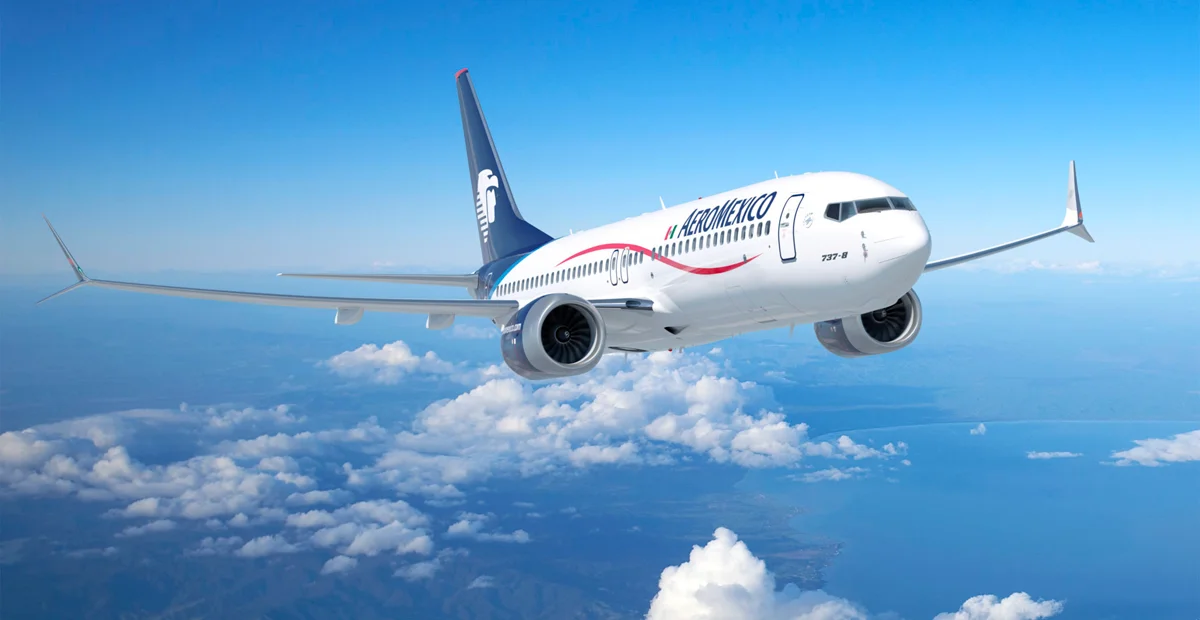Aeroméxico, officially known as Aerovías de México, S.A. de C.V., was founded on September 15, 1934, by Antonio Díaz Lombardo. The airline’s inaugural flight took place on September 14, 1934, when pilot Julio Zinser flew a Stinson SR Reliant 5A aircraft from Mexico City to Acapulco.
During its early years, Aeronaves de México (as it was originally called) operated as a small domestic carrier. The airline’s growth accelerated during World War II with support from Pan American World Airways, which acquired a 32% stake in the company. By 1955, the airline operated 15 aircraft, primarily DC-3s and DC-4s.
A pivotal moment came in 1957 when the carrier operated its first international flight using a Bristol Britannia 302, connecting Mexico City to Los Angeles and New York. The Mexican government nationalized the airline in 1959, beginning a three-decade period of state ownership. In 1971, the company officially adopted the name “Aeroméxico.”
Financial difficulties led to a crisis in 1988. On April 15 that year, the state-owned company was declared bankrupt and grounded for three months. The airline ceased operations until October 1, 1988, when it was restructured and reborn as a private company.
A significant milestone came on June 22, 2000, when Aeroméxico, along with Air France, Delta Air Lines, and Korean Air, founded the SkyTeam global airline alliance. In 2006, Aeroméxico began direct flights to Asia, initially via Tijuana to Tokyo, after purchasing Boeing 777-200ER aircraft.
More recently, Aeroméxico faced challenges during the COVID-19 pandemic, filing for Chapter 11 bankruptcy protection in 2020 but successfully emerging from this process in March 2022 with a restructured operation and renewed financial stability.
Fleet and Operations
Aeroméxico operates one of Latin America’s most modern fleets. As of 2025, the company has approximately 157 aircraft, representing a growth of about 61% over the past three years.
The airline’s mainline fleet consists exclusively of Boeing aircraft, including the 737-700, 737-800, 737 MAX 8, 737 MAX 9, 787-8 Dreamliner, and 787-9 Dreamliner. For regional operations, its subsidiary Aeroméxico Connect operates a fleet of Embraer E190 aircraft.
Aeroméxico’s operations are centered around its main hub at Mexico City International Airport (MEX), with secondary hubs in Guadalajara (GDL) and Monterrey (MTY). The airline utilizes Terminal 2 at Mexico City International Airport as its primary operations center.
The carrier operates over 600 daily flights across its network, connecting Mexico with destinations throughout North America, Central America, South America, Europe, and Asia. Aeroméxico offers three main service classes: Clase Premier (Business Class), AM Plus (Premium Economy), and Turista (Economy Class).
Quick Facts
- Full Name: Aerovías de México, S.A. de C.V.
- Founded: September 15, 1934
- First Flight: September 14, 1934 (Mexico City to Acapulco)
- Headquarters: Torre MAPFRE, Paseo de la Reforma, Mexico City
- Main Hub: Mexico City International Airport (Terminal 2)
- Secondary Hubs: Guadalajara and Monterrey International Airports
- Fleet Size: Approximately 157 aircraft (as of 2024)
- Alliance: SkyTeam (founding member since 2000)
- Destinations: Serves 101 destinations in 23 countries
- Daily Flights: Over 600
- Subsidiaries: Aeroméxico Connect (regional operations)
- CEO: Andrés Conesa
- Frequent Flyer Program: Aeroméxico Rewards (formerly Club Premier)
- IATA Code: AM
- ICAO Code: AMX
Hubs and Network
Aeroméxico’s route network spans 101 airports in 23 countries across North America, Central America, South America, the Caribbean, Europe, and Asia. The backbone of this extensive network is its hub-and-spoke system centered around three key airports in Mexico.
Mexico City International Airport (MEX) serves as Aeroméxico’s primary hub. Terminal 2 at MEX is largely dedicated to Aeroméxico’s operations, providing a streamlined experience for connecting passengers.
Guadalajara International Airport (GDL) functions as an important secondary hub, serving Mexico’s second-largest city and the surrounding western region. Monterrey International Airport (MTY) serves as Aeroméxico’s third hub, providing coverage for Mexico’s industrialized northern region.
As of 2025, Aeroméxico serves 48 domestic destinations throughout Mexico and 53 international destinations. The United States represents a key market, with service to major cities including Atlanta, Chicago, Los Angeles, Miami, New York, and Washington D.C. In Europe, Aeroméxico maintains service to cities including Madrid, Barcelona, Paris, Amsterdam, and London. The airline also operates long-haul flights to Asia, with service to Tokyo and Seoul.
Contact Information
Phone Support:
- United States: (800) 237-6639
- Mexico: (800) 021-4000
Customer Relations Email:
Headquarters Address: Aeroméxico Avenida Paseo de la Reforma 180, piso 20 Colonia Juárez Mexico City, Mexico
Website:
Aeroméxico maintains active social media accounts and offers a mobile app with flight information, booking capabilities, and check-in services. Customers can also connect through online chat options, including Facebook Messenger and WhatsApp.
The Future of Aeroméxico
Aeroméxico is positioning itself for significant growth, with plans to acquire 25 additional Boeing 737 MAX aircraft over the next 18 months. These new planes offer approximately 20% greater fuel efficiency and generate 50% less noise than previous generations. The airline is also upgrading its entire fleet of Boeing 787-8 Dreamliners to match the configuration of its 787-9 models.
Network expansion continues to be a priority, with new routes being added regularly. By the end of 2024, Aeroméxico and Delta Air Lines plan to operate over 110 daily flights between Mexico and the United States across nearly 70 routes, despite uncertainty regarding their joint venture agreement after a tentative U.S. Department of Transportation decision in January 2024.
Sustainability features prominently in Aeroméxico’s future plans. The airline has outlined a roadmap to achieve net-zero emissions by 2050, with an interim goal of increasing sustainable aviation fuel usage to 5% by 2030. Aeroméxico’s “Vuela Verde” (Fly Green) program allows customers to contribute to carbon offset initiatives.
As Aeroméxico celebrated its 90th anniversary in 2024, the airline introduced a refreshed brand image featuring an evolved version of its classic Caballero Aguila emblem from 1959, reflecting both Mexico’s rich heritage and its forward-looking approach to air travel.
Keyword: TopAirlines

